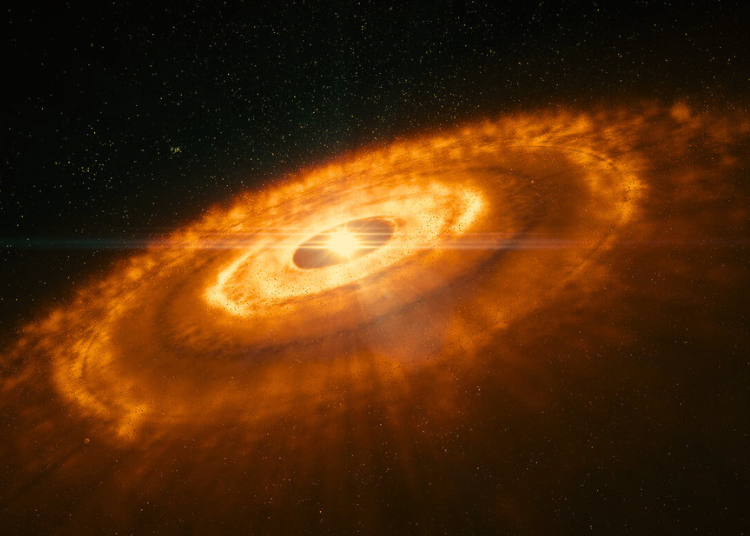For years, astronomers envisioned the birthplace of a solar system as a serene scene: a young star nestled comfortably within a flat, dusty disk – the raw material for future planets. This long-held belief offered a sense of order and predictability to the chaotic cosmos. But a recent discovery by the Very Large Telescope (VLT) in Chile throws a cosmic curveball, forcing us to rewrite the story of planetary birth.

Unveiling Miniature Galaxies: Beyond the Dusty Disk
The VLT peered into the cradles of over 80 young stars, capturing breathtaking images that shattered our previous understanding. Instead of the expected dusty discs, the telescope revealed a far more dynamic and awe-inspiring sight: miniature galaxies swirling around the nascent stars.
These “mini-galaxies” are a kaleidoscope of cosmic features. Some boast well-defined spiral arms sculpted from thick dust, resembling miniature versions of the majestic galaxies we see throughout the universe. Others exhibit wispy, clumpy clouds of glowing matter, hinting at a more chaotic environment. This unexpected complexity throws a wrench into our existing models of planet formation. It suggests the process might be far more chaotic and dynamic than we ever imagined, a cosmic ballet driven by swirling dust, intricate gravitational interactions, and the potential presence of young planets already carving their paths within the nebula.
Decoding the Cosmic Ballet: A Closer Look at Miniature Galaxies
This discovery is a goldmine for astronomers. By studying these miniature galaxies, they can delve deeper into the mysteries of planet formation. Imagine being able to refine existing models, predict the types of planets that might flourish in different environments, and even identify star systems most likely to harbour Earth-like worlds! This knowledge could revolutionize the search for extraterrestrial life, guiding us towards the most promising cosmic neighbourhoods.
For instance, the swirling filaments within these miniature galaxies might act as cosmic highways, channelling material towards nascent planets and influencing their composition and growth. Denser clumps of gas could be breeding grounds for new worlds, as gravity pulls them inward, causing them to condense and morph into planets. The VLT observations also reveal areas of turbulence within these miniature galaxies. This turbulence might play a vital role in stirring up the cosmic ingredients, ensuring a diverse mix of materials gets incorporated into the forming planets.
Unveiling the Architects: SPHERE, the Powerful Eye of the VLT
The VLT achieved this feat thanks to a powerful instrument called SPHERE. This marvel of technology acts like a cosmic eyeglass, correcting for the blurring effects of Earth’s atmosphere and producing razor-sharp images. SPHERE’s capabilities allowed astronomers to capture faint discs surrounding even the less massive stars, something that previously eluded our telescopes.
Imagine peering into the swirling heart of a nebula with unprecedented clarity. SPHERE allows astronomers to do just that, revealing the intricate structures within these miniature galaxies: the swirling filaments, the clumps of gas, and the areas of intense turbulence. This newfound detail provides invaluable insights into the dynamic processes at play during planet formation.
A New Dawn for Planetary Science: Unveiling the Future
The VLT’s discovery is a testament to the power of human curiosity and exploration. It opens doors to a whole new realm of possibilities in planetary science. Future telescopes, like the behemoth Extremely Large Telescope on the horizon, promise even more detailed views into these celestial nurseries. Imagine witnessing the birth pangs of stars and the swirling dance of dust that gives rise to new worlds!
The implications of these findings are truly groundbreaking. By studying these miniature galaxies, astronomers can refine existing models of planet formation. They can predict the types of planets that might form in different environments and identify potential locations for future exoplanet discoveries. This knowledge could revolutionize the search for extraterrestrial life, guiding us towards the most promising cosmic neighbourhoods.
The VLT’s discovery is a reminder that the universe is a place of constant surprise and wonder. As we push the boundaries of our knowledge, the cosmos continues to reveal its secrets. So, the next time you gaze at the night sky, cast your mind beyond the twinkling stars. There, in the cosmic tapestry, might lie miniature galaxies, brimming with the potential for new worlds, each one a unique product of this grand and dynamic spectacle of planet formation.



















